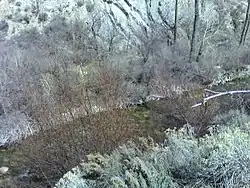American Fork (river)
The American Fork (commonly known as the American Fork River) is a river in Utah County, Utah, United States.[1]
| American Fork | |
|---|---|
 The American Fork near the mouth of American Fork Canyon, March 2007 | |
 Location of American Fork River  American Fork (river) (the United States) | |
| Etymology | To differentiate from the Spanish Fork; or derived from a company name. |
| Location | |
| Country | United States |
| State | Utah |
| County | Utah |
| Physical characteristics | |
| Source | Unnamed stream flowing through the American Fork Canyon |
| • coordinates | 40°25′54″N 111°38′12″W[1] |
| Mouth | Utah Lake |
• location | south of American Fork (city) |
• coordinates | 40°20′33″N 111°45′36″W[1] |
• elevation | 4,495 feet (1,370 m) |
| Basin features | |
| Progression | Utah Lake – Jordan River – Great Salt Lake |
Description
The river rises at the mouth of American Fork Canyon in the Wasatch Mountains about 35 miles (56 km) southeast of Salt Lake City. The unnamed stream, which is the source of the American Fork, flows from Mineral Basin, through the length of the American Fork Canyon and has several named tributaries (Silver Creek, Deer Creek, and Cattle Creek). The river runs through northern Utah County and empties into Utah Lake on its north shore.
The city of American Fork is named after this river.[2] The description "American" in the river's name is to distinguish it from the Spanish Fork (river) that also originates in the Wasatch Range; alternatively, it could have been named after the American Fur Company.[3]
Fly fishermen commonly target smaller rainbow trout (measuring 6–12 in.) – and to a lesser extent brown trout – in the river during summer and fall, when strong runoff and snowfall do not limit access.
In addition to fish, a rich community of mayflies, stoneflies, and caddisflies is also present in the American Fork river.[4]
Groundwater contribution of metals to the river
The abandoned Pacific Mine adjacent to the North Fork of the river has been a source of metals that enter the river when it is gaining stream.[5] Spill events contributing toxic metals to the river have deemed waters dangerous to humans at times,[6] but work has also been done by the U.S. Forest Service to remove tailings from mining sites.[7]
References
- U.S. Geological Survey Geographic Names Information System: American Fork
- "American Fork City - American Fork Utah". Archived from the original on 2008-12-24. Retrieved 2008-12-24.
- "Place Names on the Uinta National Forest". USDA Forest Service.
it was named to avoid confusion with the Spanish Fork River to the south, another [source claims] that it was named by early trappers and mountain men who worked the creek for beaver in the early 1800s, in reference to the American Fur Company.
- Judson, S.W., Nelson, C.R. (December 2010). Provo, UT: Monte L. Bean Life Science Museum, Brigham Young University. DIVERSITY, PHENOLOGY, AND ELEVATIONAL DISTRIBUTION OF EPHEMEROPTERA, PLECOPTERA, AND TRICHOPTERA IN AMERICAN FORK CANYON, UTAH. Retrieved from https://www.jstor.org/stable/pdf/41718097.pdf
- Lachmar, T.E., Burk, N.I. & Kolesar, P.T. Groundwater Contribution of Metals from an Abandoned Mine to The North Fork of The American Fork River, Utah. Water Air Soil Pollut 173, 103–120 (2006). https://doi.org/10.1007/s11270-005-9031-8
- May 11, 2017 3:10. Nine months after the toxic spill, American Fork was deemed no longer dangerous. The Salt Lake Tribune. Retrieved February 24, 2022, from https://archive.sltrib.com/article.php?id=5276678&itype=CMSID
- Lachmar, T.E., McDonough, H.L., Burk, N.I. et al. Effect of Ore Mineralogy and Bedrock Lithology on Metal Loading Rates and Acid-Mine Drainage: Bayhorse Creek, Idaho and the North Fork of the American Fork River, Utah. Mine Water Environ 38, 3–15 (2019). https://doi.org/10.1007/s10230-018-00574-1